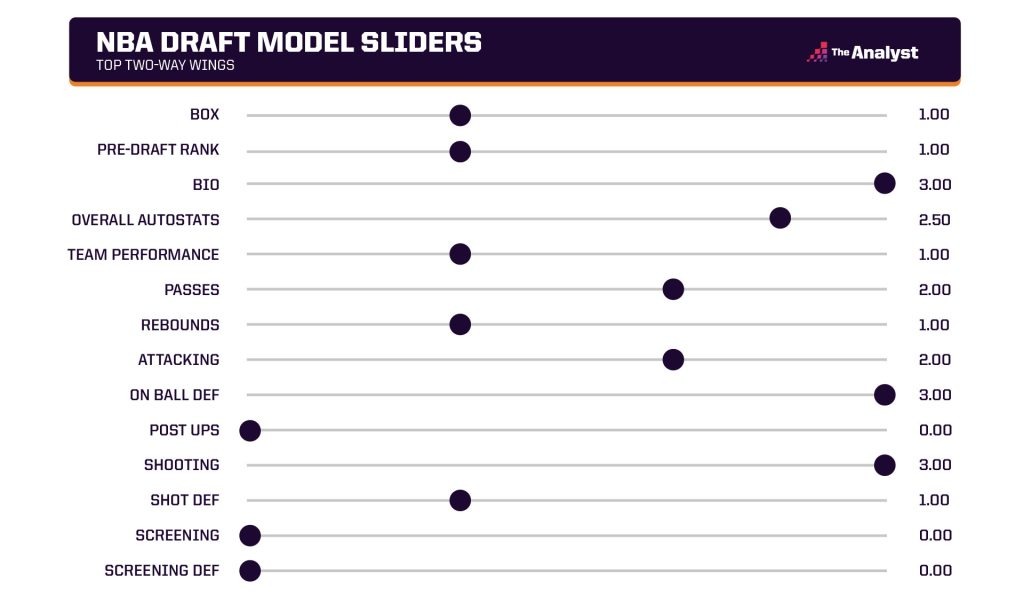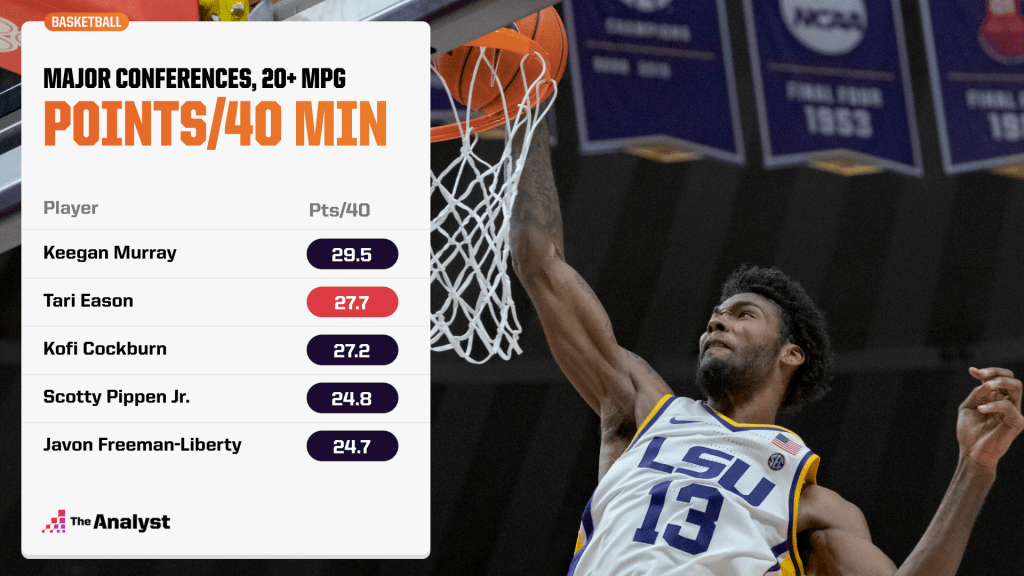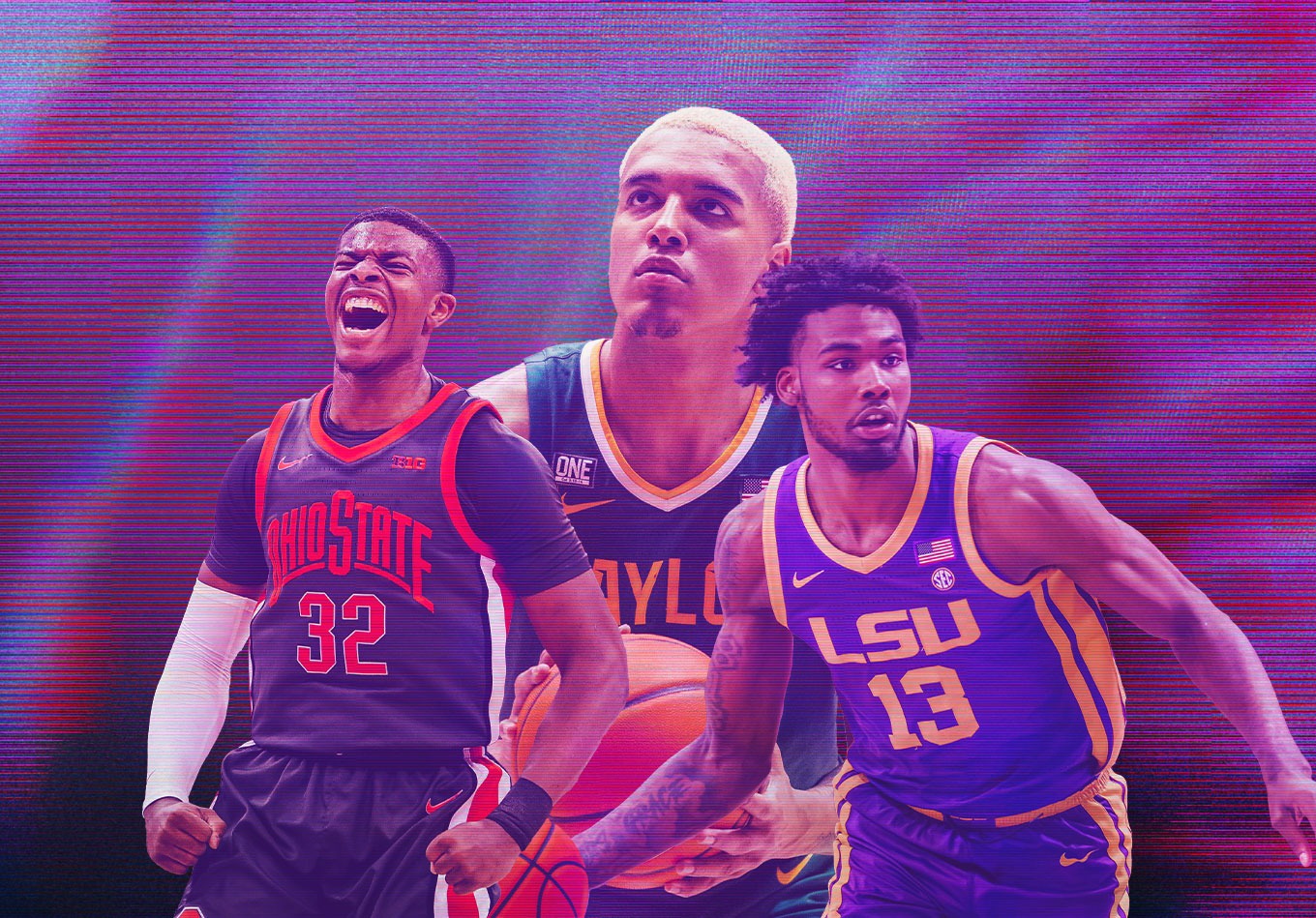Every NBA team is looking for a two-way wing.
That’s not to say all teams need to be built around two-way players on the wing. The NBA champion Golden State Warriors were anchored by one of the all-time great point guards and one of the most versatile defenders ever.
But the advantage of the two-way wing is roster flexibility. If there isn’t already an elite player on a team to build around, wings who can shoot, defend and pass can generally play in the most lineups.
Take the Cleveland Cavaliers for example. Even if the team identified a great big in the draft, it would be difficult to find enough minutes for Jarrett Allen, Evan Mobley and the new player to deploy them all effectively. Same goes for a small guard on the Portland Trail Blazers joining Damian Lillard and Anfernee Simons (assuming Simons stays in Portland as a restricted free agent).
But even a team like the Boston Celtics, who have two young elite wings, could use another one. The team could easily play another wing alongside Jayson Tatum and Jaylen Brown if the player was useful at both ends of the floor.
So teams that aren’t sure what kind of lineup they’re building should go with a wing that has potential at both ends of the court if that player is in the same draft tier as a different type of player. And there are several playoff teams that need more of these types of players as well.
Thanks to the sliders on our NBA Draft model, we can use data to try and find some of the players that offer two-way potential at the wing. The sliders can be used to emphasize certain physical and statistical traits and compare them to current NBA players’ stats at the time they were entering the league.
Our draft model is derived from an array of volume- and rate-based statistical inputs, consensus draft rankings and biographical/anthropometric information to determine where a prospect stands relative to his peers in the class. It now also includes data from AutoStats, which leverages AI-enhanced body recognition technology to identify player position and movement across the entirety of the court.
In our search for two-way wings, we emphasized shooting, on-ball defense, and bio data the most (see sliders below). The bio data includes basic physical traits such as height, weight and wingspan. This allows us to compare players physically and statistically, which is imperative for looking at players that can handle the wing in the NBA.
We also have the ability to set the DRIP (a projection of a player’s contribution to a team’s plus-minus per 100 possessions) at any point over the first six years of the prospect’s career, depending on what point in the development process you want to forecast. For our purposes, the rankings are based on DRIP heading into Year 4 of their NBA careers.

Our secondary characteristics that were emphasized somewhat were passing, attacking and AutoStats data. It’s no longer enough to be a “3-and-D” wing. Players on the wing in the modern NBA must be able to drive or make the correct extra read against a rotating defense. And AutoStats data is extremely useful in tracking player movements and likening them to successful players in today’s NBA.
We’ll call the model’s rankings with these traits emphasized as “two-way wing rankings.”
It comes as no surprise that the two-way wing rankings have the consensus top-five players (Jabari Smith of Auburn, Chet Holmgren of Gonzaga, Paolo Banchero of Duke, Jaden Ivey of Purdue and Keegan Murray of Iowa) in the top five. But let’s examine some players who the model thinks might be undervalued, starting at No. 6.
Jeremy Sochan, Baylor (Two-Way Wing Ranking: 6)
It’s surprising to see Sochan, whose biggest question is his shot, grade out so well when shooting was one of the emphasized components.
But Sochan does everything else so well. He’s a great and willing passer for his height. His attacking grades out well as he’s able to draw a lot of contact and finish with both hands. Even if the shot doesn’t come along, he’s a smart player who does enough other things well to not be a massive liability on that end.
And, as long as the shooting limitations don’t push him off the floor, Sochan will make an impact defensively. He grades out well as a one-on-one defender on all types of players, displaying the versatility needed to be a building block on that end.
The 6-foot-9 Sochan is the type of defender you appreciate the more you see him.
Sochan had some highlight plays on defense, but this isn’t one of them. It is, however, the kind of play Sochan made correctly in college way more often than most do at his age. He communicates a switch, fights through a screen and contests without fouling or allowing the offensive player any advantage.
His defensive instincts are usually right, and he’s athletic enough to use them. It’s hard to imagine Sochan being anything less than a very good defender in a switching scheme, and his ability to communicate and help and recover as often as he does could allow teams to keep worse defenders on the floor with him.
That brings us back to the shot. He’s only 19 and, aesthetically speaking, it’s not the worst-looking shot in the world. Though it can’t be assumed he’ll turn into a great shooter with his numbers in college, there is a reason the model likes him despite that.
If he’s able to turn into a solid shooter, he could be a star. Even if he doesn’t, his ability to affect the game in all other areas could make him a valuable pick.
Tari Eason, LSU (Two-Way Wing Ranking: 7)
The 6-foot-8 Eason is the most interesting prospect in the draft outside the top three picks. Watch a highlight package of him, and you’ll assume he’s going in the top five. Catch him on the right night, and he looks unstoppable.
Catch him on the wrong night, and you’ll see him turning it over on simple reads. Or you won’t see him much at all. He fouled out in seven minutes against Florida, one of six games he fouled out of this season. Eason was only fifth on the team in minutes and a lot of that had to due with foul trouble.
He likely would’ve started instead of being the SEC Sixth Man of the Year if he could’ve stayed on the floor more often. But the minutes he did play were tantalizing as he led the team in scoring despite his often limited time on the floor. In fact, among those who played at least 20 minutes per game in major conferences, Eason finished behind only Iowa’s Keegan Murray in points per 40 minutes.

Eason did foul a lot, but he also drew a lot of fouls. Among those who played at least 20 minutes per game in major conferences, he was fourth in free-throw attempts per 40 minutes. And his free throw shooting improved dramatically from his freshman to sophomore year, going from 57.4% to 80.3%.
His 3-point percentage also went from 24.1% as a freshman at Cincinnati to 35.9% as a sophomore at LSU, indicating he has the ability to improve as a shooter.
He can handle the ball, especially in transition. Eason was one of the most exciting defense-to-offense players in college basketball.
He may not be handling the ball here, but he gets from incredible defensive play to transition one-on-one in a heartbeat. And he’s a runaway freight train going downhill.
While teams at the top of the draft will likely be scared away by the foul and turnover issues, he has tremendous upside on both sides on the ball. The model indicates teams in the middle of the first round would be making a worthwhile investment betting on Eason’s talent.
E.J. Liddell, Ohio State (Two-Way Wing Ranking: 14)
Liddell is an interesting player. His primary scoring skills were on full display in college, but all the damage he did in the post will be a secondary skill at the pro level as he takes on a smaller load on offense. However, his secondary skills were also very good in college and suggest he can play a role as a valuable rotation member at the next level.
Liddell’s improvements on both sides of the ball as a junior make him a better fit for the NBA. He improved his 3-point shooting from 33.8% to 37.4% his junior year, to go along with a solid 76.5 free-throw percentage. He also improved dramatically on defense, and profiles as a switchable defender that can play a small-ball five.
His defensive improvement was evident early this season, as he gave top-prospect Paolo Banchero fits in an upset win over Duke.
Banchero went just 4 of 14 from the field that night with three turnovers. While Liddell was a junior and Banchero was still adjusting early in his freshman season, that game still holds a lot of weight for what Liddell could do on defense.
The athletic questions are there for the 6-foot-7 Liddell, as a lot of his scoring was done with craft and strength in college. And he is 21 and a half years old, making him older than a lot of prospects.
But an NBA player comparison generated by our model indicates the role he could have in the league. Liddell’s No. 2 comparison is Grant Williams, and this makes a lot of sense. Coming out of college, Williams was also a heady, switchable player, just quick enough to get by defending faster forwards. He had enough offensive skill to be thrive in a complementary role on that end as well. And while he struggled the last two rounds of the playoffs, Williams was vital in helping the Celtics take down the Milwaukee Bucks and in giving Boston lineup flexibility.
If Liddell could be a solid rotation player that can play in multiple lineup constructions, hit 3s and play tough defense, he would provide a ton of value as a mid-round pick. There’s a reason the two-way wing model likes him – he brings a lot of characteristics of the modern swingman to the table.
Data modeling provided by Matt Scott of Stats Perform. Graphic design by Matt Sisneros.
Enjoy this? Subscribe to our mailing list to receive exclusive weekly content.
